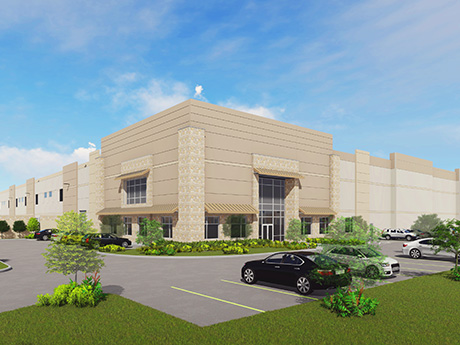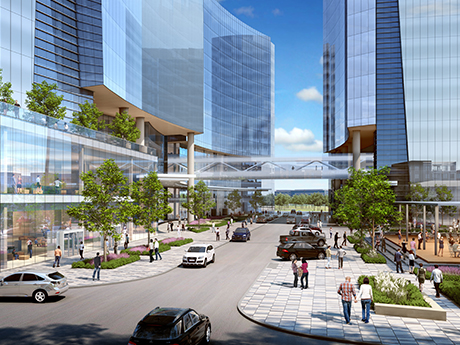By Conrad Madsen, SIOR, co-founder and partner, Paladin Partners; and Kipp Collins, partner, Paladin Partners Just 20 years ago, the conventional wisdom and commonly held belief throughout the Dallas commercial real estate scene was that office and retail were preferable sectors to be in versus industrial. Looking back and reflecting on how industrial has gone from ugly duckling to white swan in just 20 short years, we can’t help but be glad that we didn’t take that advice. Led by Amazon, e-commerce has truly changed the world, and certainly industrial real estate by extension. Everyone talks about how e-commerce is what’s driving the explosion of warehouse and distribution center development and absorption across Dallas-Fort Worth (DFW) and beyond. But the fact of the matter is, e-commerce still only accounts for about 14 percent of total retail sales, according to data from the U.S. Census Bureau. Think about that for a moment — the current proportion of 14 percent leaves a tremendous amount of room for additional growth. Demand for warehouse and distribution space is through the roof; developers can’t build warehouses fast enough these days, and yet the market is nowhere close to reaching its peak. Inventory Growth There is …
Texas Market Reports
By Taylor Williams Office owners in Texas remain acutely aware of how the pandemic has changed the game and are not shying away from promoting health and wellness within their buildings. According to data from security firm Kastle Systems, which tracks keycard, fob and app access to some 2,600 office buildings across 138 cities and 47 states, office space in America’s largest markets continues to be underutilized. Across the 10 markets that Kastle Systems tracks, including Austin, Houston and Dallas, the average office occupancy rate in early December was 40.6 percent. Yet the three Texas markets all registered occupancy rates considerably above the national average — 59.3 percent, 54.9 percent and 52.3 percent, respectively — for Austin, Houston and Dallas. A more temperate climate in Texas could bear some responsibility for these above-average performances, given that access to functional outdoor spaces has undeniably become a key tenant demand during the pandemic. Along those lines, tenants have understood for some time now that successfully bringing their employees back to their offices is somewhat contingent on making sure those workers feel safe on the job. The onus, therefore, has fallen on office owners to ensure that their buildings have protocols through which …
By Zack Taylor, senior vice president, Colliers Houston’s industrial market continued to see strong leasing activity in the third quarter. Overall net absorption for 2021 should easily pass 20 million square feet, making it the best year on record by a long shot. For context, Houston’s industrial market has, on average, absorbed between 8 million and 11 million square feet of space per year since 2014. Houston’s North and Southwest submarkets absorbed the most space in the third quarter of this year, led by Lowe’s Home Improvement taking down 1.5 million square feet and Amazon taking 1.9 million square feet in each of those respective submarkets. Total marketwide leasing volume for the year is well over 30 million square feet and does not show any signs of stopping as we hit the midpoint of the fourth quarter. Direct vacancy is continuing its downward trend, but rental rates have largely remained the same on new product. Second-generation infill warehouses are experiencing the greatest increase in rents, especially for tenants with requirements between 20,000 and 50,000 square feet. Many of these tenants are faced with a dilemma: They can either accept higher rents for their infill locations or relocate to more expensive …
By Blake Virgilio, SIOR, CCIM, vice president at Colliers The Houston office market continued its very gradual stabilization with 27,000 square feet of positive absorption in the third quarter. While that volume of absorption only represents roughly one floor of office space in a typical Houston office building, it’s the first time the market has posted a quarter of positive net absorption in the last two years. The key activities of tenant tours and the return of employees to the office continued to increase throughout the third quarter. Nonetheless, the vacancy rate rose over the course of the quarter by 400 basis points from 22.9 to 23.3 percent, a historical high. Also in the most recent quarter, Houston’s office inventory increased slightly, with approximately 1 million square feet of new product added. There is still 3.2 million square feet of office space under construction, and most of the new inventory, which is 47 percent preleased, is expected to deliver this year. Of that total new product, about 2.3 million square feet is spec development, of which 60 percent is preleased. Houston has one of the highest physical office occupancy rates in the country, though many larger corporations began phasing their …
By Jeff Tinsley, senior advisor, SVN | J. Beard Real Estate – Greater Houston As we reach the end of the calendar year, it’s become clear that 2021 has been a year of transition. Many new trends are emerging from the pandemic year of 2020 with regard to retail real estate. COVID-19-induced trends within shopping, dining and entertainment have given rise to a new generation of retailers to the Houston market. Many quick-service restaurants (QSRs) are looking to reduce store sizes for future locations and focus on streamlining their drive-thru, call in and pick-up order service. Some restaurant concepts are instilling the use of “ghost kitchens” and are aggressively looking to lease second-generation spaces in order to take advantage of the growing takeout and delivery demands. During the pandemic, one of the hardest-hit sectors was in the restaurant industry. Following months of minimized interaction between customers and proprietors due to dining room closures, we are now seeing a greater increase in pick-up and delivery requirements. Many restaurants are now using new technology and methods in terms of how service is offered, how food is prepared and how kitchen and service areas are designed. Furthermore, many food and …
By Jeffrey Brown, FAIA, founding principal and CEO, Powers Brown Architecture San Antonio, with its 1.5 million residents, occupies an enigmatic identity, flying under the radar as the second-largest city in Texas and the seventh-largest city in the nation. Located between the south and central regions of the Lone Star State, San Antonio’s economy is fueled by tourism, military, financial services, energy and healthcare providers. Its lower-than-average cost of living and high quality of life make the “Alamo City” attractive for development. There is no mystery about San Antonio’s steady growth among locals, including developers, several of whom have created exciting new hyper-urban mega-developments in Central Business District (CBD)-adjacent locations. The recent announcement of Riverplace by Universal Services Group, part of the development team behind the recently completed Thompson Hotel and Arts Residences, reached an agreement last December with the City of San Antonio that paves the way for a $400 million development in the center city. Anchored by the Dream Hotel, Riverplace is the newest bookend to the various new projects and developments in the CBD, with the oldest bookend being the Pearl District, one of the original CBD-adjacent efforts. Riverplace and the Pearl District make up either end …
By Joe Iannacone, senior vice president, Titan Development; and Omar Nasser, senior vice president, AQUILA Commercial The Central Texas industrial market stretches between Austin and San Antonio along the Interstate 35 “Innovation” Corridor, an approximately 80-mile expanse that encompasses some of the fastest-growing cities in the nation. Austin, now the 10th-largest city in the nation population-wise, continues to see unprecedented growth in the tech, e-commerce and household industry sectors. Most notably, Tesla decided to construct its Cybertruck Gigafactory in East Austin along State Highway 130, which has and will be a boon to the region. The electric car maker also recently announced plans to relocate its headquarters from Silicon Valley to Austin. San Antonio, the nation’s seventh-largest city, has seen continued growth in the automotive, financial, life sciences and food and beverage sectors. Large companies continue to flock to the region to establish a major presence, including USAA, H-E-B and Toyota. The markets in between Austin and San Antonio from south to north — Schertz, New Braunfels, San Marcos, Kyle and Buda — have benefitted from the synergies of both markets due to their location and strong economies. As a result of the continued economic activity and with the effects …
By Matt Epple, executive vice president, Weitzman Austin; and David Nicolson, president, Weitzman San Antonio One of the best-known metroplexes — a term that was coined way back in 1915 to describe the phenomenon whereby two or more important cities expand to form one continuous urban area — in the country is Dallas-Fort Worth (DFW). Now, new data from the U.S. Census Bureau has led the Texas State demographer to predict that Texas’ next new mega metro will be Austin-San Antonio. Austin gained nearly 200,000 new residents over the past decade for a growth rate of 21 percent. San Antonio added 107,218 people and is one of the top 10 largest U.S. cities by population. Together, the two markets form a powerhouse metro area of nearly 5 million people. The Austin and San Antonio metro areas each represent robust economies with strong population, job and housing growth. Together, they are almost unbeatable. While the markets are on track to merge into a metroplex, for now they are each distinct enough that we produce separate research reports. But without a doubt, these two metro areas account for some of the most positive retail performance in the state. In formulating this market …
By Taylor Williams A number of economic, demographic and bureaucratic headwinds are propelling investment in self-storage properties across Texas, such that some brokerage firms are on pace to have record-breaking deal volumes in 2021. Last year, the outbreak of COVID-19 postponed the typical leasing season of late spring and early summer. Individuals and businesses grappled with economic uncertainty by tightening their purse strings. But by fall of last year, leasing and occupancy rates had rebounded, making it clear to investors that self-storage assets tended to flow cash better than other property sectors. Consequently, a number of players shifted out of asset classes like retail, office and hospitality and into the more stable self-storage space. The early months of the pandemic also coincided with the natural tapering off of the development cycle in Texas. Numerous submarkets in major Texas cities had become overbuilt in the years leading up to 2020, and COVID-19 served as an additional governor on new supply, further bolstering leasing velocity and rent growth. And as the federal government pumped trillions of dollars of aid into the economy, ushering in a new era of inflation, investors were able to adjust their revenues to cover rising costs with ease.” …
By Greg Langston, principal, managing director, Avison Young The Dallas North Tollway (DNT) is a staple thoroughfare for Dallas Fort-Worth (DFW), connecting the metroplex’s urban core in Dallas to the thriving northern suburbs. Over the past 12 years, since the recovery from the Great Recession began, much of the market’s activity and energy has occurred along this tollway. Weighing the performance of assets in submarkets that connect to the DNT versus those that don’t, those in DNT-connected submarkets have outperformed in total and in annualized averages. Centers of Action Three core submarkets — Uptown/Turtle Creek in the urban core, Upper Tollway/West Plano and Frisco/The Colony in the far north region — have driven much of this growth. The northern suburbs have done a great job attracting massive corporate headquarters and relocations deals, while Uptown/Turtle Creek has created a unique identity as a thriving urban hub full of walkable amenities, mixed-use developments and more. Beyond the DNT, major developments like Cypress Waters have helped drive strong interest and activity to the center of the region. To the west, Tarrant and Denton counties have seen robust growth along State Highway 114, with several major institutional employers like Deloitte, Charles Schwab and Fidelity …











